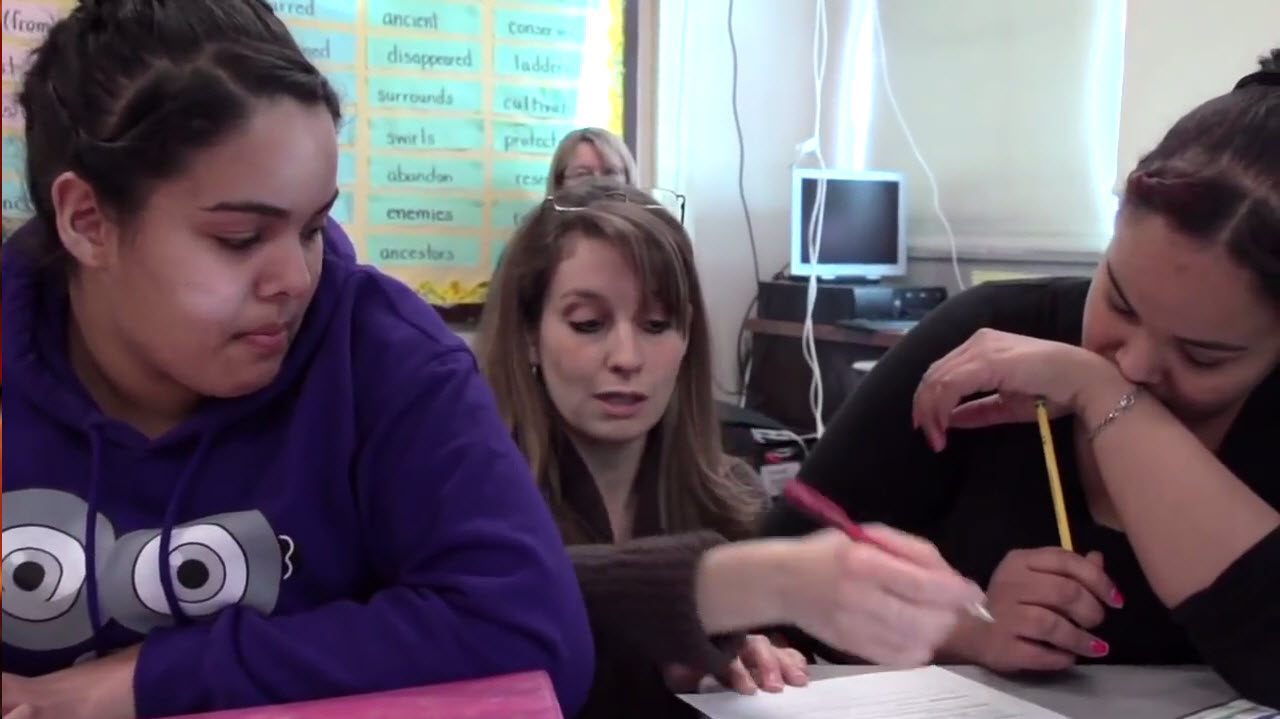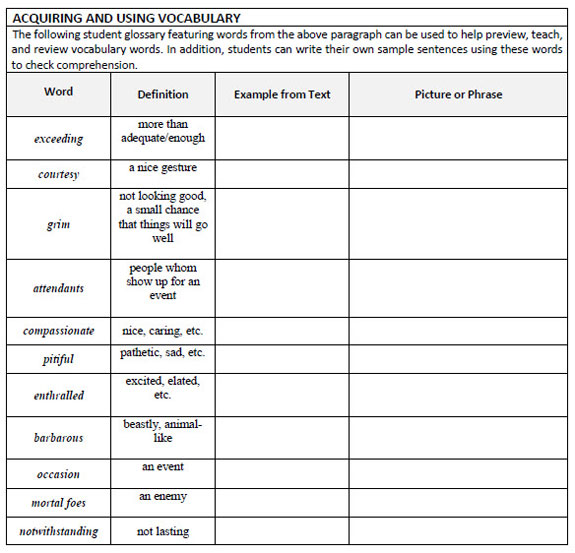An Innovative High School CCSS Lesson for ELLs: Letters from John Smith

In my concluding postal service, I shared Colorin Colorado's new multimedia project filmed with ELLs and ESL teachers in Poughkeepsie, NY. This week, I'd like to delve a fiddling deeper into one of the loftier school lessons taught by ESL teacher Anne Formato. Every bit I highlight the lesson "Teaching of Central Academic Vocabulary with High School ELLs," I'll share innovative aspects of this lesson that volition get out you with some strategies you might consider for your own ELLs, fifty-fifty if they're not at the high school level. I'll focus on how this lesson innovates by: (1) using unlike class level standards than the students' actual grade, (ii) including student-friendly objectives, and (3) reinforcing academic vocabulary in multiple ways. I'll close with some thoughtful reflections from Ms. Formato about language learning and the challenges her ELLs face up.
ELL Innovation #1: Choice of Course Level for Standards
In this lesson for ninth form ELLs, students read a letter that Captain John Smith of the English Ground forces wrote to Queen Anne in 1616. He wrote this letter about his encounters with the Algonquin Indians of Virginia. The lesson focuses on academic vocabulary from the 2nd paragraph.
I chose to examine this lesson a little more closely because, although it's taught to ninth grade ELLs, it's based on 7th grade Mutual Core Standards in English Language Arts and Literacy. As you may know, the CCSS increase in complexity and sophistication as new skills and concepts are added to each form level from the previous year, forming a screw progression through class levels. Here's a comparing of the seventh grade standards with the 9th grade standards. You'll see the differences between the ii in boldface.
Seventh Course Standards Compared to Ninth Grade Standards
| 7th Grade Standard (With Differences in Bold) | ixth Grade Standard (With Differences in Bold) |
|---|---|
| Determine a theme or central idea of a text and clarify its evolution over the course of the text; provide an objective summary of the text. (RL.7.2) | Determine a theme or central idea of a text and clarify in detail its development over the course of the text, including how it emerges and is shaped and refined by specific details; provide an objective summary of the text. (RL.nine.two) |
| Engage effectively in a range of collaborative discussions (ane-on-one, in groups, and teacher-led) with diverse partners on grade vii topics, texts, and issues, building on others' ideas and expressing their own clearly. (SL.seven.1) | Initiate and participate effectively in a range of collaborative discussions (one-on-i, in groups, and instructor-led) with diverse partners on grades 9–10 topics, texts, and bug, building on others' ideas and expressing their own clearly and persuasively. (SL.ix.ane) |
| Acquire and utilize accurately grade-advisable general academic and domain-specific words and phrases. (L.7.vi) | Larn and use accurately general academic and domain-specific words and phrases, sufficient for reading, writing, speaking, and listening at the higher and career readiness level; demonstrate independence in gathering vocabulary knowledge when considering a word or phrase important to comprehension or expression. (LS.9.6) |
ELL expert Diane August has suggested using the strategy of basing instruction on a lower grade's Common Core standards for ELLs who are at lower levels of English proficiency to back up them as they work towards standards at their grade level. Fifty-fifty though the Helm John Smith lesson is based on seventh grade standards, the lesson is notwithstanding circuitous and challenging, but it also allows ELLs an opportunity to succeed in meeting the Mutual Cadre standards it'south based on while preparing them to meet the Class 9 CCSS in English Language Arts and Literacy.
ELL Innovation #2: Student-Friendly Objectives
Another innovative attribute of this lesson is that it includes student-friendly objectives (or objectives written in language that ELLs volition understand) for all the standards the lesson is based on. For example, the reading (literature) standard for the lesson is: Determine a theme or primal idea of a text and analyze its development over the class of the text; provide an objective summary of the text. (RL.7.two) The lesson objective and student objective are the following:
Lesson Objective: Students volition make up one's mind the central theme of the excerpts and volition be able to provide supporting details from the text.
Pupil Objective: I will determine, or find out the key idea of the text. I will find details (pieces of information) in the text that support the central idea.
It stands out to me how the teacher embeds the significant of certain terms (e.g., determine and details) in the student objective. And so, students are not only increasing their understanding of the lesson objective through the student objective, merely they're also learning some academic vocabulary forth the way. I similar that 2-for-one special!
ELL Innovation #three: Reinforcing Academic Vocabulary
 The tertiary innovation is the way in which bookish vocabulary is reinforced throughout the lesson. Ms. Formato identifies bookish vocabulary the students will demand and makes distinctions betwixt Tier 1, 2, and 3 words during instruction. It's evident through the video how she has students utilise the new vocabulary throughout the lesson via discussion, examples, and student-generated sentences. Yous can detect all the lesson materials here (PDF), including the text, glossary, and the vocabulary matrix pictured to the left.
The tertiary innovation is the way in which bookish vocabulary is reinforced throughout the lesson. Ms. Formato identifies bookish vocabulary the students will demand and makes distinctions betwixt Tier 1, 2, and 3 words during instruction. It's evident through the video how she has students utilise the new vocabulary throughout the lesson via discussion, examples, and student-generated sentences. Yous can detect all the lesson materials here (PDF), including the text, glossary, and the vocabulary matrix pictured to the left.
Teacher Reflection
In a series of teacher reflection videos linked to this lesson, Ms. Formato draws upon her by experience as a bilingual speaker of English and Italian and describes feeling like she was always "in the spotlight" in terms of feeling self-conscious near her emerging bilingualism. She offers an insightful quote about how she has students "ain the light that they're in" – to help them "make the stage their ain" and produce linguistic communication they're proud of and feel comfortable with, fifty-fifty if information technology isn't exactly perfect. She recognizes the diversity of her high school ELLs, including students with interrupted formal education (SIFE), students who are significant, ELLs who besides receive special education services, and those who are thinking of dropping out. She says was proud of her students for "showing up," although it'southward often far from unproblematic for many of them to show up to school, and for doing their all-time. Her reflections solidify my belief that the nigh constructive teachers of ELLs are ones who actually know their students' strengths and challenges and back up their students on both an academic and personal level.
Which of the innovations used in this lesson resonate the near with you? Which take you tried, and what effects did they have on your teaching? Which might you consider using this yr?
Source: https://www.colorincolorado.org/blog/innovative-high-school-ccss-lesson-ells-letters-john-smith
0 Response to "An Innovative High School CCSS Lesson for ELLs: Letters from John Smith"
Post a Comment